In Swift 5.5 iOS 15+ and Mac Catalyst 15+ there is a
There is a new solution with adaptiveSheetPresentationController
https://developer.apple.com/documentation/uikit/uipopoverpresentationcontroller/3810055-adaptivesheetpresentationcontrol?changes=__4
@available(iOS 15.0, *)
struct CustomSheetParentView: View {
@State private var isPresented = false
var body: some View {
VStack{
Button("present sheet", action: {
isPresented.toggle()
}).adaptiveSheet(isPresented: $isPresented, detents: [.medium()], smallestUndimmedDetentIdentifier: .large){
Rectangle()
.frame(maxWidth: .infinity, maxHeight: .infinity, alignment: .center)
.foregroundColor(.clear)
.border(Color.blue, width: 3)
.overlay(Text("Hello, World!").frame(maxWidth: .infinity, maxHeight: .infinity)
.onTapGesture {
isPresented.toggle()
}
)
}
}
}
}
@available(iOS 15.0, *)
struct AdaptiveSheet<T: View>: ViewModifier {
let sheetContent: T
@Binding var isPresented: Bool
let detents : [UISheetPresentationController.Detent]
let smallestUndimmedDetentIdentifier: UISheetPresentationController.Detent.Identifier?
let prefersScrollingExpandsWhenScrolledToEdge: Bool
let prefersEdgeAttachedInCompactHeight: Bool
init(isPresented: Binding<Bool>, detents : [UISheetPresentationController.Detent] = [.medium(), .large()], smallestUndimmedDetentIdentifier: UISheetPresentationController.Detent.Identifier? = .medium, prefersScrollingExpandsWhenScrolledToEdge: Bool = false, prefersEdgeAttachedInCompactHeight: Bool = true, @ViewBuilder content: @escaping () -> T) {
self.sheetContent = content()
self.detents = detents
self.smallestUndimmedDetentIdentifier = smallestUndimmedDetentIdentifier
self.prefersEdgeAttachedInCompactHeight = prefersEdgeAttachedInCompactHeight
self.prefersScrollingExpandsWhenScrolledToEdge = prefersScrollingExpandsWhenScrolledToEdge
self._isPresented = isPresented
}
func body(content: Content) -> some View {
ZStack{
content
CustomSheet_UI(isPresented: $isPresented, detents: detents, smallestUndimmedDetentIdentifier: smallestUndimmedDetentIdentifier, prefersScrollingExpandsWhenScrolledToEdge: prefersScrollingExpandsWhenScrolledToEdge, prefersEdgeAttachedInCompactHeight: prefersEdgeAttachedInCompactHeight, content: {sheetContent}).frame(width: 0, height: 0)
}
}
}
@available(iOS 15.0, *)
extension View {
func adaptiveSheet<T: View>(isPresented: Binding<Bool>, detents : [UISheetPresentationController.Detent] = [.medium(), .large()], smallestUndimmedDetentIdentifier: UISheetPresentationController.Detent.Identifier? = .medium, prefersScrollingExpandsWhenScrolledToEdge: Bool = false, prefersEdgeAttachedInCompactHeight: Bool = true, @ViewBuilder content: @escaping () -> T)-> some View {
modifier(AdaptiveSheet(isPresented: isPresented, detents : detents, smallestUndimmedDetentIdentifier: smallestUndimmedDetentIdentifier, prefersScrollingExpandsWhenScrolledToEdge: prefersScrollingExpandsWhenScrolledToEdge, prefersEdgeAttachedInCompactHeight: prefersEdgeAttachedInCompactHeight, content: content))
}
}
@available(iOS 15.0, *)
struct CustomSheet_UI<Content: View>: UIViewControllerRepresentable {
let content: Content
@Binding var isPresented: Bool
let detents : [UISheetPresentationController.Detent]
let smallestUndimmedDetentIdentifier: UISheetPresentationController.Detent.Identifier?
let prefersScrollingExpandsWhenScrolledToEdge: Bool
let prefersEdgeAttachedInCompactHeight: Bool
init(isPresented: Binding<Bool>, detents : [UISheetPresentationController.Detent] = [.medium(), .large()], smallestUndimmedDetentIdentifier: UISheetPresentationController.Detent.Identifier? = .medium, prefersScrollingExpandsWhenScrolledToEdge: Bool = false, prefersEdgeAttachedInCompactHeight: Bool = true, @ViewBuilder content: @escaping () -> Content) {
self.content = content()
self.detents = detents
self.smallestUndimmedDetentIdentifier = smallestUndimmedDetentIdentifier
self.prefersEdgeAttachedInCompactHeight = prefersEdgeAttachedInCompactHeight
self.prefersScrollingExpandsWhenScrolledToEdge = prefersScrollingExpandsWhenScrolledToEdge
self._isPresented = isPresented
}
func makeCoordinator() -> Coordinator {
Coordinator(self)
}
func makeUIViewController(context: Context) -> CustomSheetViewController<Content> {
let vc = CustomSheetViewController(coordinator: context.coordinator, detents : detents, smallestUndimmedDetentIdentifier: smallestUndimmedDetentIdentifier, prefersScrollingExpandsWhenScrolledToEdge: prefersScrollingExpandsWhenScrolledToEdge, prefersEdgeAttachedInCompactHeight: prefersEdgeAttachedInCompactHeight, content: {content})
return vc
}
func updateUIViewController(_ uiViewController: CustomSheetViewController<Content>, context: Context) {
if isPresented{
uiViewController.presentModalView()
}else{
uiViewController.dismissModalView()
}
}
class Coordinator: NSObject, UIAdaptivePresentationControllerDelegate {
var parent: CustomSheet_UI
init(_ parent: CustomSheet_UI) {
self.parent = parent
}
//Adjust the variable when the user dismisses with a swipe
func presentationControllerDidDismiss(_ presentationController: UIPresentationController) {
if parent.isPresented{
parent.isPresented = false
}
}
}
}
@available(iOS 15.0, *)
class CustomSheetViewController<Content: View>: UIViewController {
let content: Content
let coordinator: CustomSheet_UI<Content>.Coordinator
let detents : [UISheetPresentationController.Detent]
let smallestUndimmedDetentIdentifier: UISheetPresentationController.Detent.Identifier?
let prefersScrollingExpandsWhenScrolledToEdge: Bool
let prefersEdgeAttachedInCompactHeight: Bool
private var isLandscape: Bool = UIDevice.current.orientation.isLandscape
init(coordinator: CustomSheet_UI<Content>.Coordinator, detents : [UISheetPresentationController.Detent] = [.medium(), .large()], smallestUndimmedDetentIdentifier: UISheetPresentationController.Detent.Identifier? = .medium, prefersScrollingExpandsWhenScrolledToEdge: Bool = false, prefersEdgeAttachedInCompactHeight: Bool = true, @ViewBuilder content: @escaping () -> Content) {
self.content = content()
self.coordinator = coordinator
self.detents = detents
self.smallestUndimmedDetentIdentifier = smallestUndimmedDetentIdentifier
self.prefersEdgeAttachedInCompactHeight = prefersEdgeAttachedInCompactHeight
self.prefersScrollingExpandsWhenScrolledToEdge = prefersScrollingExpandsWhenScrolledToEdge
super.init(nibName: nil, bundle: .main)
}
required init?(coder: NSCoder) {
fatalError("init(coder:) has not been implemented")
}
func dismissModalView(){
dismiss(animated: true, completion: nil)
}
func presentModalView(){
let hostingController = UIHostingController(rootView: content)
hostingController.modalPresentationStyle = .popover
hostingController.presentationController?.delegate = coordinator as UIAdaptivePresentationControllerDelegate
hostingController.modalTransitionStyle = .coverVertical
if let hostPopover = hostingController.popoverPresentationController {
hostPopover.sourceView = super.view
let sheet = hostPopover.adaptiveSheetPresentationController
//As of 13 Beta 4 if .medium() is the only detent in landscape error occurs
sheet.detents = (isLandscape ? [.large()] : detents)
sheet.largestUndimmedDetentIdentifier =
smallestUndimmedDetentIdentifier
sheet.prefersScrollingExpandsWhenScrolledToEdge =
prefersScrollingExpandsWhenScrolledToEdge
sheet.prefersEdgeAttachedInCompactHeight =
prefersEdgeAttachedInCompactHeight
sheet.widthFollowsPreferredContentSizeWhenEdgeAttached = true
}
if presentedViewController == nil{
present(hostingController, animated: true, completion: nil)
}
}
/// To compensate for orientation as of 13 Beta 4 only [.large()] works for landscape
override func viewWillTransition(to size: CGSize, with coordinator: UIViewControllerTransitionCoordinator) {
super.viewWillTransition(to: size, with: coordinator)
if UIDevice.current.orientation.isLandscape {
isLandscape = true
self.presentedViewController?.popoverPresentationController?.adaptiveSheetPresentationController.detents = [.large()]
} else {
isLandscape = false
self.presentedViewController?.popoverPresentationController?.adaptiveSheetPresentationController.detents = detents
}
}
}
@available(iOS 15.0, *)
struct CustomSheetView_Previews: PreviewProvider {
static var previews: some View {
CustomSheetParentView()
}
}
iOS 16 Beta
In iOS 16 Beta Apple provides a pure SwiftUI solution for a Half-Modal.
.sheet(isPresented: $showSettings) {
SettingsView()
.presentationDetents:(
[.medium, .large],
selection: $settingsDetent
)
}
You can also add custom detents and specify the percentages
static func custom<D>(D.Type) -> PresentationDetent
//A custom detent with a calculated height.
static func fraction(CGFloat) -> PresentationDetent
//A custom detent with the specified fractional height.
static func height(CGFloat) -> PresentationDetent
//A custom detent with the specified height.
Example:
extension PresentationDetent {
static let bar = Self.fraction(0.2)
}
.sheet(isPresented: $showSettings) {
SettingsView()
.presentationDetents:([.bar])
}


